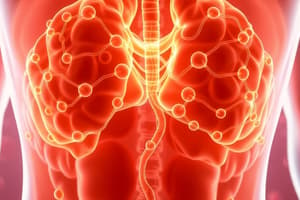Podcast
Questions and Answers
In which zone of the adrenal cortex is the most potent glucocorticoid primarily produced?
In which zone of the adrenal cortex is the most potent glucocorticoid primarily produced?
- Zona reticularis
- Zona medullaris
- Zona fasciculata (correct)
- Zona glomerulosa
Which enzyme is responsible for the initial hydroxylation at the C17 position in cortisol synthesis?
Which enzyme is responsible for the initial hydroxylation at the C17 position in cortisol synthesis?
- 17α-hydroxylase (correct)
- 21-hydroxylase
- 3 β-OHSD
- 11 β-hydroxylase
What is the intermediate product formed directly after the action of 3 β-OHSD and Δ5 4 isomerase on 17-hydroxypregnenolone?
What is the intermediate product formed directly after the action of 3 β-OHSD and Δ5 4 isomerase on 17-hydroxypregnenolone?
- 11-deoxycortisol
- Cortisol
- Progesterone
- 17-hydroxyprogesterone (correct)
Which of the following is NOT correctly matched with its enzyme action site during cortisol synthesis?
Which of the following is NOT correctly matched with its enzyme action site during cortisol synthesis?
Which enzyme catalyzes the final step in cortisol synthesis?
Which enzyme catalyzes the final step in cortisol synthesis?
What is the role of 21-hydroxylase in cortisol synthesis?
What is the role of 21-hydroxylase in cortisol synthesis?
Study Notes
Glucocorticoids Synthesis
- Glucocorticoids synthesis occurs in the zona fasciculata and to a lesser extent in the zona reticularis.
- The most potent glucocorticoid produced is cortisol.
- Cortisol synthesis requires three hydroxylases that act sequentially on the C17, C21, and C11 positions.
Cortisol Synthesis Steps
- 17α-hydroxylase, a smooth endoplasmic reticulum enzyme, acts on pregnenolone to produce 17-hydroxypregnenolone.
- 17-hydroxypregnenolone is converted into 17-hydroxyprogesterone by the action of 3 β-OHSD and Δ5 4 isomerase.
- Additionally, a small amount of 17-hydroxyprogesterone is produced by the action of 17α-hydroxylase on progesterone.
- 17-hydroxyprogesterone is hydroxylated at C21 to form 11-deoxycortisol, a potent mineralocorticoid, by the action of 21-hydroxylase enzyme.
- 11-deoxycortisol leaves the smooth endoplasmic reticulum and enters the mitochondria, where it is subjected to another hydroxylation at C11 by the action of 11 β-hydroxylase enzyme, forming cortisol.
Studying That Suits You
Use AI to generate personalized quizzes and flashcards to suit your learning preferences.
Description
Learn about the synthesis of glucocorticoids, specifically cortisol, in the zona fasciculata and zona reticularis of adrenal glands.




